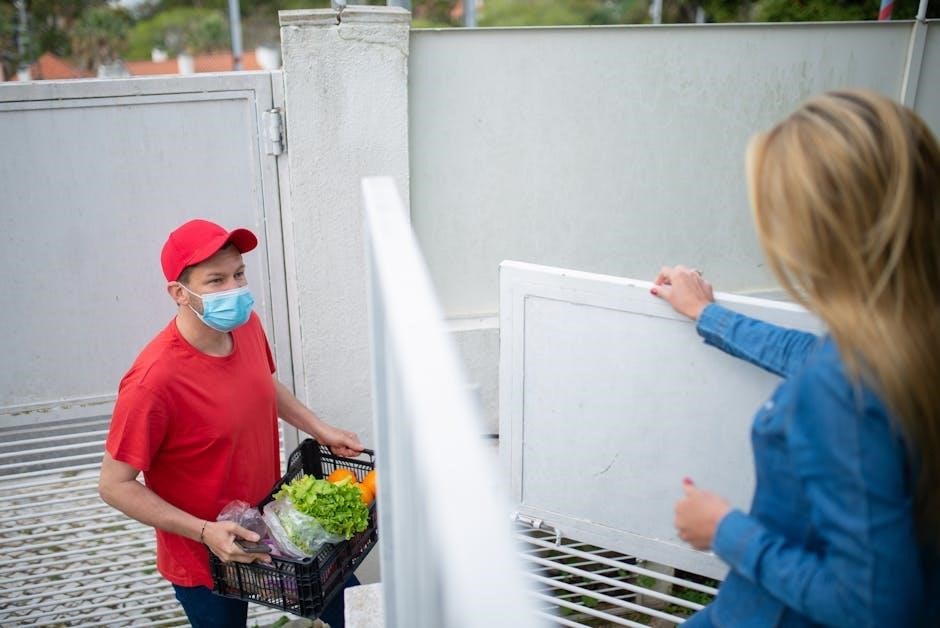rural customer delivery instructions
Understanding rural delivery challenges is crucial for ensuring timely and efficient service. Clear instructions help address infrastructure limitations and weather impacts, enhancing customer satisfaction and reducing delays significantly.
Overview of Rural Delivery Challenges
Rural delivery challenges often stem from infrastructure limitations, such as unpaved roads and lack of street signs, which can hinder navigation. Weather conditions like heavy snow or floods further complicate delivery timelines. Additionally, couriers may face reluctance to serve remote areas due to higher fuel costs and longer travel times. In some cases, refusals to deliver prepaid orders in rural areas highlight systemic issues. The US Postal Service has also considered slowing mail delivery in rural zones to cut costs, emphasizing the need for clear instructions and communication strategies to manage customer expectations effectively in such scenarios.
Importance of Clear Delivery Instructions
Clear delivery instructions are vital for ensuring smooth rural deliveries, as they help address infrastructure limitations and reduce delays. Detailed directions enable couriers to navigate challenging terrains and locate remote addresses efficiently. They also minimize the risk of delivery refusals, as seen in cases where couriers decline to serve rural areas due to high costs or logistical hurdles. Providing specific instructions, such as alternate delivery points or preferred contact methods, empowers customers to manage their shipments effectively. This clarity fosters trust and satisfaction, especially when combined with realistic expectations and regular updates, ensuring a seamless delivery experience for rural customers.
Key Considerations for Rural Deliveries
Rural deliveries require addressing infrastructure challenges, weather impacts, and the need for precise instructions to ensure timely and efficient service in remote areas.
Understanding Rural Infrastructure Limitations
Rural areas often face challenges such as unpaved roads, limited street signage, and sparse populations, which can hinder delivery efficiency. Infrastructure limitations like these require couriers to adapt their routes and strategies. Additionally, weather conditions like heavy snow or flooding can further complicate access. Understanding these challenges is essential for developing effective delivery plans tailored to rural settings. By addressing these limitations, businesses can improve service reliability and customer satisfaction in remote areas.
Impact of Weather Conditions on Deliveries
Weather conditions significantly affect rural deliveries, with challenges like snowstorms, heavy rain, and extreme temperatures. These can make roads impassable, delaying shipments and increasing logistical complexity. In rural areas, where infrastructure is already limited, poor weather exacerbates difficulties, such as unpaved roads becoming muddy or icy. Additionally, severe weather can damage delivery vehicles and disrupt communication systems. Understanding these weather-related challenges is crucial for developing resilient delivery strategies. By anticipating and preparing for adverse conditions, couriers can minimize delays and ensure reliable service, maintaining customer trust and satisfaction in remote regions.
Role of Local Couriers in Rural Areas
Local couriers play a vital role in rural deliveries by providing personalized and efficient service. Their familiarity with the area ensures timely delivery despite infrastructure limitations. They often act as trusted intermediaries, offering flexible solutions tailored to community needs. Local couriers can handle unique challenges, such as navigating unpaved roads or delivering to remote locations, with greater ease than larger services. Their deep understanding of the region enables them to adapt quickly to changes and maintain reliable service. This makes them indispensable in ensuring customer satisfaction and maintaining the integrity of the delivery process in rural settings.

Best Practices for Rural Delivery Logistics
Optimize routes, use reliable GPS tracking, and ensure proper packaging to enhance efficiency and customer satisfaction in rural delivery logistics.
Planning Delivery Routes Efficiently
Efficient route planning is critical for rural deliveries, where infrastructure limitations and unpredictable weather can cause delays. Use GPS tracking and route optimization software to map the most direct paths, reducing fuel costs and delivery times. Consult local couriers familiar with the terrain to identify potential bottlenecks and alternate routes. Regularly update delivery schedules based on real-time data, such as weather conditions or road closures; Prioritize customer needs, ensuring timely arrivals while minimizing detours. Clear communication with drivers and customers about route adjustments is essential for maintaining trust and efficiency in rural delivery operations.
Use of GPS Tracking for Rural Deliveries
GPS tracking is essential for managing rural deliveries effectively. It enables real-time monitoring of delivery vehicles, ensuring drivers stay on optimal routes and adhere to schedules. This technology helps navigate challenging rural terrains, where road signs may be limited or unpredictable weather conditions arise. By providing precise location data, GPS tracking allows companies to proactively address delays and improve delivery accuracy. Customers also benefit from real-time updates, enhancing transparency and trust. Integrating GPS with route optimization software further streamlines operations, reducing fuel consumption and lowering costs. This technology is a cornerstone of efficient and reliable rural delivery systems.
Importance of Proper Packaging for Rural Shipments
Proper packaging is vital for rural shipments to ensure items arrive undamaged. Rural deliveries often involve longer transit times and unpredictable weather conditions, making durable packaging essential. Sturdy materials protect against rough handling, moisture, and temperature fluctuations. Clearly labeled packages also prevent misdelivery and ensure timely arrival. Additionally, proper packaging helps reduce returns and associated costs. Businesses should consider weather-resistant materials and reinforced containers for fragile items. Clear labeling with recipient details and handling instructions further enhances delivery efficiency. Investing in quality packaging minimizes risks and improves customer satisfaction in rural areas where delivery challenges are more pronounced.

Customer Communication Strategies
Effective communication ensures transparency and trust with rural customers. Regular updates on delivery status and clear expectations are key to managing satisfaction and reducing concerns in remote areas.
Setting Realistic Delivery Expectations
Setting realistic delivery expectations is vital for rural customers, as infrastructure limitations and unpredictable weather can delay shipments. Clearly communicating expected timelines helps manage customer anticipation and reduces frustration. Providing detailed tracking information and regular updates ensures transparency. Businesses should account for longer delivery times in rural areas compared to urban regions, as routes may be less frequented. Offering flexible delivery options, such as alternative drop-off points, can enhance customer satisfaction. By aligning expectations with operational capabilities, companies can build trust and improve overall delivery experiences in rural settings.
Providing Regular Updates on Delivery Status
Regular updates on delivery status are essential for rural customers, ensuring transparency and reducing anxiety. Use mobile apps or SMS notifications to keep customers informed about delays or changes. Proactively alert customers if weather or infrastructure issues impact delivery timelines. Providing a tracking link allows customers to monitor their shipments independently. Clear communication builds trust and satisfaction, especially in areas with limited connectivity; Ensure updates are timely and accurate, addressing any concerns promptly. This proactive approach helps manage expectations and strengthens customer relationships in rural delivery scenarios.
Handling Customer Inquiries Effectively
Effective handling of customer inquiries is vital for maintaining satisfaction in rural deliveries. Provide clear contact options, such as phone, email, or live chat, and ensure responses are prompt and informative. Train customer support teams to address common rural delivery challenges, like delays due to weather or infrastructure. Use technology, such as mobile apps, to offer real-time updates and resolve issues quickly. Proactively communicate potential disruptions and offer solutions to minimize frustration. Personalized support and empathy go a long way in building trust with rural customers, who may face unique delivery challenges compared to urban areas.

Technology in Rural Delivery Management
Technology modernizes rural delivery systems through GPS tracking, route optimization, and mobile apps, enhancing efficiency and customer service quality in remote areas significantly.
Role of Route Optimization Software
Route optimization software plays a vital role in streamlining rural deliveries by planning the most efficient routes, reducing fuel consumption, and lowering emissions. It enables couriers to adjust routes in real-time, accounting for weather, traffic, and road conditions. This technology ensures timely deliveries, minimizes delays, and enhances customer satisfaction. By analyzing data, it helps carriers avoid unnecessary detours, especially in areas with limited infrastructure. Additionally, it supports cost savings for businesses and improves resource allocation. Overall, route optimization software is essential for overcoming logistical challenges in rural areas, ensuring reliable and efficient delivery services.
Use of Mobile Apps for Delivery Tracking
Mobile apps provide real-time tracking, enabling customers to monitor their deliveries seamlessly. Notifications and updates ensure transparency, reducing anxiety about delivery status. These apps allow customers to communicate directly with couriers, resolving issues promptly. Features like live tracking and estimated delivery times enhance customer satisfaction. Additionally, mobile apps offer a platform for feedback, helping improve services. They also empower couriers to manage deliveries efficiently, ensuring timely arrivals. By leveraging mobile technology, businesses can streamline rural delivery operations, build trust, and foster long-term customer relationships. This technology is vital for overcoming rural delivery challenges and ensuring a smooth experience for all parties involved.
Automation in Rural Delivery Systems
Automation is transforming rural delivery systems by enhancing efficiency and reducing human error. Advanced technologies like route optimization software and automated sorting systems streamline operations, ensuring faster and more accurate deliveries. Automated notifications keep customers informed about delivery statuses, improving transparency. Additionally, automation enables real-time tracking, allowing for better management of logistics. Machine learning algorithms can predict delivery times and adapt to changing conditions, such as weather or traffic. By integrating automation, businesses can reduce costs, improve scalability, and maintain high service standards in remote areas. This technological advancement is essential for meeting the growing demands of rural customers and ensuring satisfaction.
Legal and Compliance Aspects
Compliance with delivery regulations is essential to avoid legal issues. Understanding liability and documentation requirements ensures adherence to laws, protecting both businesses and rural customers effectively always.
Understanding Delivery Regulations in Rural Areas
Delivery regulations in rural areas often differ due to unique challenges like limited infrastructure and weather conditions. Carriers must adhere to specific guidelines, such as completing deliveries within mandated timeframes and handling signature requirements. PS Form 4232 instructions outline how rural customers can manage mail handling preferences. Additionally, regulations may require carriers to notify customers about delivery delays or changes. Compliance with local and federal laws ensures consistent service quality. Understanding these regulations is essential for maintaining customer satisfaction and operational efficiency in rural delivery operations.
Liability Considerations for Rural Deliveries
Liability considerations for rural deliveries are critical due to unique challenges such as unpredictable weather and limited infrastructure. Carriers must adhere to regulations to minimize risks, such as accidents or delays caused by inclement weather. Proper documentation, like PS Form 4232, ensures clarity in handling customer preferences and reduces legal disputes. Liability may arise from damaged goods or missed deliveries, emphasizing the need for clear communication and adherence to delivery protocols. Understanding these factors helps carriers navigate potential legal and financial implications, ensuring smooth operations and maintaining customer trust in rural areas.
Importance of Documentation in Rural Delivery
Accurate documentation is essential for rural deliveries to ensure clarity and accountability. Forms like PS Form 4232 guide how rural customers prefer their mail handling, reducing disputes. Detailed records of delivery attempts, signatures, and package conditions provide a clear audit trail. Proper documentation helps resolve issues quickly and ensures compliance with regulations. It also aids in tracking delivery history, which is vital for addressing customer inquiries. Clear instructions and records minimize errors, ensuring smooth operations and maintaining trust between customers and delivery services in rural areas.
Case Studies and Success Stories
Successful rural delivery models highlight effective logistics optimization and technology integration, improving delivery reliability and customer satisfaction in remote areas significantly.
Successful Rural Delivery Models
Successful rural delivery models often involve partnerships with local businesses and leveraging community networks. For instance, decentralizing delivery hubs and using local couriers ensures faster and more reliable service. Technology integration, such as GPS tracking and real-time updates, enhances transparency and efficiency. Additionally, offering flexible delivery options, like parcel lockers or alternate delivery points, caters to rural customers’ needs. These models emphasize adaptability, customer-centric solutions, and collaboration with local stakeholders to overcome infrastructure and logistical challenges. By aligning delivery processes with rural dynamics, businesses can achieve higher customer satisfaction and operational efficiency in remote areas.
Lessons Learned from Rural Delivery Challenges
Rural delivery challenges highlight the need for adaptability and customer-centric solutions. Infrastructure limitations and unpredictable weather often disrupt schedules, emphasizing the importance of flexible delivery options. Courier refusal for rural deliveries underscores the need for clear policies and training. Implementing alternative delivery methods, like parcel lockers, can mitigate such issues. Proactive communication with customers and real-time updates are crucial for managing expectations. Additionally, leveraging local partnerships and technology, such as GPS tracking, improves efficiency. Documenting challenges and incorporating customer feedback into delivery strategies fosters long-term improvements and enhances overall service quality in rural areas.
Customer Feedback on Rural Delivery Experiences
Customer feedback highlights both challenges and successes in rural delivery services. Many appreciate the convenience of home delivery, while others face issues like delays or courier refusals. Rural customers often emphasize the importance of clear communication and realistic expectations. Regular updates on delivery status are highly valued, as mail access can be limited. Some customers report satisfaction with alternative delivery options, such as parcel lockers or local pickup points. However, infrastructure limitations and weather-related disruptions remain common pain points. Feedback underscores the need for flexible solutions and improved service reliability to enhance overall satisfaction in rural areas. Continuous improvement is key to meeting customer needs.
Future Trends in Rural Delivery
The growth of e-commerce in rural areas is driving demand for faster, more reliable delivery solutions. Emerging technologies, like drones and AI, are expected to transform logistics, while sustainability initiatives will play a key role in shaping the future of rural delivery services.
Impact of E-Commerce Growth on Rural Deliveries
The surge in e-commerce has increased demand for rural deliveries, presenting both opportunities and challenges. Rural areas often face infrastructure limitations, making delivery efficiency difficult. Businesses must adapt to meet growing customer expectations while addressing logistical hurdles. The U.S. Postal Service has considered slowing mail delivery in rural areas to cut costs, which could impact e-commerce fulfillment. Clear delivery instructions and technology, such as GPS tracking, are essential to ensure seamless service. As e-commerce continues to grow, companies must innovate to maintain customer satisfaction and operational efficiency in rural regions.
Emerging Technologies for Rural Delivery Solutions
Emerging technologies are transforming rural delivery systems, enhancing efficiency and reliability. Drones and autonomous delivery robots are being tested to navigate challenging terrains, reducing reliance on traditional infrastructure. Electric vehicles (EVs) are becoming more common, offering eco-friendly solutions for last-mile deliveries. Real-time tracking through mobile apps provides customers with transparency, improving trust. Additionally, route optimization software leverages AI to minimize delivery times and fuel consumption. These innovations address historical challenges, ensuring faster and more sustainable service in rural areas. As technology advances, rural deliveries are becoming more accessible and customer-centric, bridging the gap between urban and rural logistics.
Sustainability Initiatives in Rural Delivery Services
Sustainability is a growing focus in rural delivery services, aiming to reduce environmental impact while maintaining efficiency. Companies are adopting electric vehicles (EVs) and hybrid fleets to lower carbon emissions. Route optimization software minimizes fuel consumption by reducing unnecessary miles. Additionally, eco-friendly packaging is being prioritized to decrease waste. Solar-powered delivery hubs are emerging as innovative solutions for energy efficiency. These initiatives not only benefit the environment but also enhance customer satisfaction by aligning with eco-conscious values. As sustainability becomes a key differentiator, rural delivery services are embracing greener practices to meet both business and environmental goals effectively.
Rural customer delivery instructions are essential for overcoming challenges like infrastructure limitations and unpredictable weather. Clear communication and efficient logistics ensure timely deliveries, while technology tools like GPS tracking enhance accuracy. Understanding local regulations and maintaining proper documentation are critical for compliance. Customer satisfaction is boosted through realistic expectations, regular updates, and effective inquiry handling. Emerging technologies and sustainability initiatives promise to further improve rural delivery systems. By addressing these key areas, businesses can create a robust framework for reliable and efficient rural deliveries, adapting to the unique needs of these areas while ensuring customer trust and satisfaction.
Final Thoughts on Improving Rural Deliveries
Improving rural deliveries requires a combination of technology, infrastructure investment, and customer-centric strategies. Implementing route optimization software and GPS tracking can significantly enhance efficiency. Collaboration with local couriers ensures better familiarity with rural terrains. Clear communication and realistic expectations are vital for customer satisfaction. Additionally, sustainable practices, such as eco-friendly packaging and fuel-efficient vehicles, can reduce environmental impact. Continuous feedback from customers and delivery personnel helps identify gaps and refine processes. By addressing these aspects, businesses can build a reliable and adaptable delivery system tailored to rural areas, ensuring long-term success and customer trust.

References
For further insights, refer to USPS guidelines on rural delivery practices and courier service recommendations for remote areas. Explore resources on logistics optimization and customer feedback analysis.
Relevant Resources for Further Reading
For deeper insights into rural delivery challenges, explore resources like the USPS Rural Delivery Handbook and case studies from logistics experts. Academic journals such as NC Coombs’ 2022 study on rural healthcare delivery offer valuable perspectives. Online forums and articles discussing courier challenges in remote areas provide practical solutions. Additionally, government publications on rural infrastructure and e-commerce growth trends are essential reads. These resources collectively offer a comprehensive understanding of the complexities and opportunities in rural customer delivery systems.
Links to Useful Tools and Services
Explore essential tools like USPS Rural Delivery Handbook for detailed guidelines. Utilize route optimization software to streamline logistics. Check out GPS tracking devices for real-time monitoring. Visit US Postal Service for updated regulations. Access NC Coombs’ 2022 study on rural delivery challenges. Use mobile apps for customer updates and tracking. Refer to e-commerce platforms for tailored solutions. These resources provide practical support for enhancing rural delivery efficiency and customer satisfaction.